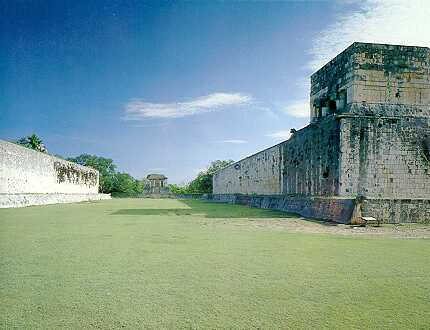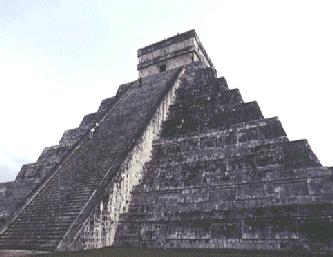| Chichén-Itzá |
| Palenque |
| Uxmal |
| Yaxchilàn |
| Tulum |
| Cobá |
| Dzibilchaltún |
| Teotihuacan |
| Tula |
| Home |
Chichén-Itzá was not always Mayan, in fact, it had been abandoned and resettled several times. It has been the site for many pilgrimages over the years. The Toltecs were among one of the most influential groups to have settled this area. They were highly intellectual architects and had significant influence on architectural structures of this site, as well as others.
Among the ancient people of Chichén, as it is referred to for short, there existed a strong practice of carrying out human sacrifices. These sacrifices were made to their water god. This practice made them out to be a fierce people, and many others were fearful of them.
This site literally means "mouth of the well of Itzá," for it corresponds with a critical element of the city, its two wells. Chichén-Itzá has two wells, one that was deemed sacred and the other profane. The profane well was used all the time but the one which was sacred was only used for worship. Archeological divers have retrieved skeletons and ritual objects from the sacred well depths.
The art and architecture of Chichén
adheres greatly to the character of its people. One such piece of architectural
splendor is the renowned Ball Court. This is a 272ft by 199ft field
with a raised platform on the side that is thought to have been used for
dance performances or half-time entertainment for sports events.

Another major and magnificent structure, at Chichén-Itzá, is the Pyramid El Castillo , which is the site of the Equinox solar phenomena. The solar phenomena itself is a shadow that appears during the equinoxes in which a serpent is depicted climbing up the pyramid’s steps in March and down them in September.
El Castillo is 78 feet tall
and literally means "castle" in Spanish. It is the pyramid which is most
notably accredited to not only the equinox phenomena but dedicated to the
god Kukulcan, or more familiarly, Quetzacoatl.

This site represents the time temple
serving the foundation for the Mayan astronomical system. Literally,
it is an enlarged, highly magnified solar calendar, in that, if you did
the math, you would find that the 91 steps on each side, times 4 for each
side and each season, plus 1 for the crowning platform adds up to 365;one
step for each day of the solar year.
(http:www.gorp.com/gorp/location/latamer/mexico/arc_maya.htm#palenque)